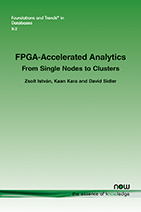FPGA-Accelerated Analytics: From Single Nodes to Clusters
By Zsolt István, IMDEA Software Institute, Spain, zsolt.istvan@imdea.org | Kaan Kara, Oracle Labs, Switzerland, kaan.kara@oracle.com | David Sidler, Microsoft Corporation, USA, david.sidler@microsoft.com
Abstract
In this monograph, we survey recent research on using reconfigurable hardware accelerators, namely, Field Programmable Gate Arrays (FPGAs), to accelerate analytical processing. Such accelerators are being adopted as a way of overcoming the recent stagnation in CPU performance because they can implement algorithms differently from traditional CPUs, breaking traditional trade-offs. As such, it is timely to discuss their benefits in the context of analytical processing, both as an accelerator within a single node database and as part of distributed data analytics pipelines. We present guidelines for accelerator design in both scenarios, as well as, examples of integration within full-fledged Relational Databases. We do so through the prism of recent research projects that explore how emerging compute-intensive operations in databases can benefit from FPGAs. Finally, we highlight future research challenges in programmability and integration, and cover architectural trends that are propelling the rapid adoption of accelerators in datacenters and the cloud.
FPGA-Accelerated Analytics: From Single Nodes to Clusters
Datacenters hosting the data-intensive applications used in machine learning and online services are facing an important challenge: the amount of data that needs to be stored and processed is increasing at an exponential rate whereas traditional processor performance has been stagnating for years as Moore’s Law tapers off. Driven by these trends, data processing and management applications have become increasingly distributed leading to new data movement bottlenecks at various levels of the software and hardware architecture. The authors show how specialized hardware accelerators can provide an answer to the compute stagnation problem and be helpful in reducing data movement bottlenecks by placing them in the right location within the computer architecture. They concentrate on Field Programmable Gate Arrays (FPGAs) and show how they make it possible to express algorithms in ways that are fundamentally different from CPUs or GPUs. Many major companies are using these accelerator techniques in their storage and processing offerings.
The authors discuss the benefits of using FPGAs in the context of analytical processing, both as an accelerator within a single node database and as part of distributed data analytics pipelines. They present guidelines for accelerator design in both scenarios and examples of integration within full-fledged Relational Databases. They do so through the prism of recent research projects that explore how emerging compute-intensive operations in databases can benefit from FPGAs. Finally, they highlight future research challenges in programmability and integration and cover architectural trends that are propelling the rapid adoption of accelerators in datacenters and the cloud.
The monograph provides researchers and practitioners a concise insight into how FPGAs can play an important role in designing modern data-intensive computing systems. Drawing on both theory and practical implementations the readers are brought quickly up to speed on a technique that will significantly improve a system’s performance.
